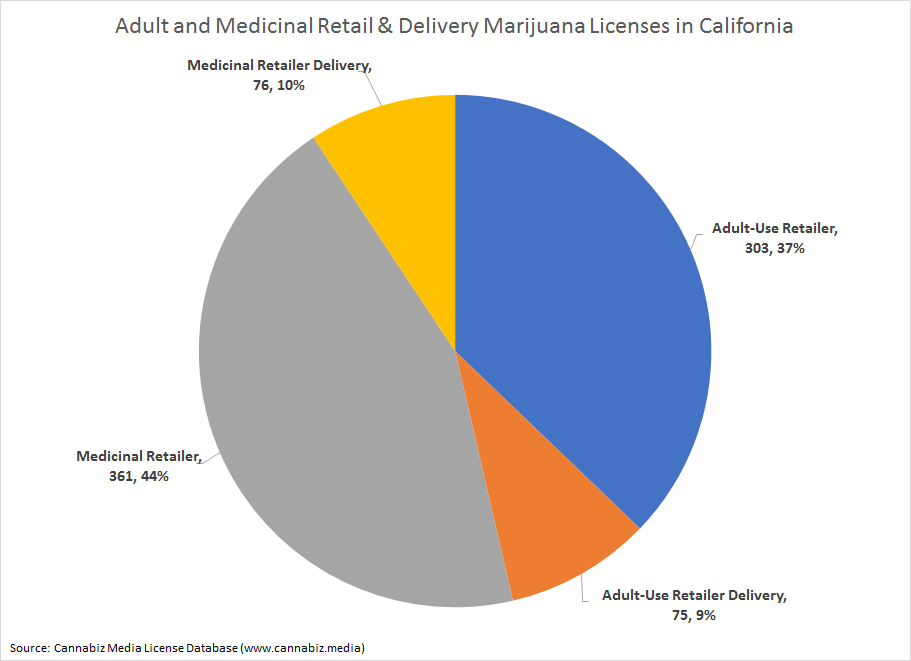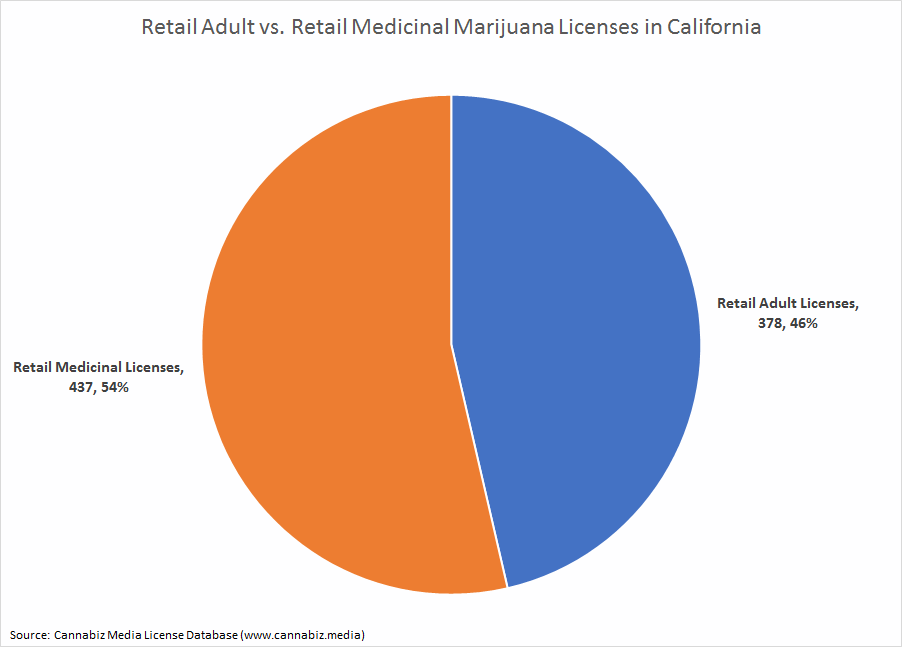Marijuana Licenses in California – Part 4
Guest post by Ed Keating, Co-Founder and Chief Data Officer at Cannabiz Media
Part 4 of Cannabiz Media’s 6-part series about marijuana licenses in California analyzes the state’s retail and dispensing licenses. If you missed the previous parts of the series, you can follow the links to read them now: Part 1: California Overview, Part 2: California Cultivation, and Part 3: Manufacturing.
California’s Marijuana Retail Licenses
The Bureau of Cannabis Control is responsible for licensing retailers/dispensaries, distributors, testing laboratories, microbusinesses, and temporary cannabis events in California. The term “dispensary” isn’t used in California to identify medical marijuana dispensaries as other states do. Instead, California differentiates between the adult-use and medical markets by granting “adult retailer” and “medicinal retailer” licenses.
Retailer licenses in California are further categorized by the operations the licensed business is involved in:
- Non-Storefront Retailer (Delivery): A licensed non-storefront retailer sells and delivers cannabis or cannabis products to consumers. While the retailer must have licensed premises, those premises are not open to the public. Instead, sales are conducted exclusively by delivery.
- Retailer (Storefront Sales): A licensed retailer sells and delivers cannabis and cannabis products to consumers through licensed premises that are open to the public. Retailer sales can also be conducted by delivery.
Not including micro-licenses, there are 815 licensed retailers in California with slightly more medicinal retailer licenses (54%) than adult retailer licenses (46%) as shown in the chart below. Note that this does not mean there are 815 licensed retail outlets as some license holders are securing adult and medicinal licenses at the same location.
The 815 retailer licenses can be further broken down by activity as shown in the chart below with 44% of all licenses held by medicinal retailers with storefronts, 37% held by adult retailers with storefronts, 9% held by medicinal delivery-only retailers, and 9% held by adult delivery-only retailers.
Keep in mind, California’s recreational marijuana market is just three months old, so all of these licenses are temporary at this point in time.
Where are California’s Marijuana Retailer Licenses?
Nearly half of all marijuana retailer licenses (49%) are in just three of California’s 58 counties: Los Angeles (28%), Alameda (11%), and San Francisco (10%). Expanding that a bit, more than three out of four retailer licenses (76%) are in eight counties: Los Angeles, Alameda, San Francisco, Sacramento (9%), Riverside (6%), Orange (5%), San Diego (4%), and Santa Cruz (3%).
In terms of license concentration by city, 50% of California’s marijuana retailer licenses are in seven cities: Los Angeles (11%), San Francisco (10%), Oakland (9%), Sacramento (9%), Santa Ana (5%), San Diego (3%), and Cathedral City (2%). In total, retailer licenses can be found in 110 California cities.
Who Has the Retailer Licenses in California?
The 815 retailer licenses in California are held by 514 license holders. Similar to marijuana manufacturing licenses in California, there are no dominant license holders with 232 license holders having just one license each and 272 having two licenses each.
Only three license holders have three licenses (420 Central, Higher Level, and Stone Age Farmacy) while five have four licenses (East Bay Therapeutics, Hometown Heart, KindPeoples, Monex Place Wellness, Inc., and urbn leaf) and two have five licenses (SPARC and The Apothecarium).
It’s likely there is little concentration in license holders simply because the challenges of complying with regulations in 530+ jurisdictions across the state doesn’t make strategic sense in California’s current marijuana market.
Looking at the large number of retail license holders that have one license each, it’s possible that many of these license holders are legacy dispensaries that want to keep doing what they’ve been doing for years as the state’s market evolves around them.
Coming up Next in the Marijuana Licenses in California Series
Part 5 of the Marijuana Licenses in California series will compare California’s marijuana licenses to other states.
Read the Rest of the Series
- Marijuana Licenses in California – Part 1 (Overview)
- Marijuana Licenses in California – Part 2: Cultivation
- Marijuana Licenses in California – Part 3: Manufacturing

About the author:
Ed Keating is a co-founder of Cannabiz Media and oversees our data research and government relations efforts. He has spent his whole career working with and advising information companies in the compliance space. Ed has overseen complex multijurisdictional product lines in the securities, corporate, UCC, safety, environmental and human resource markets and focuses on workflow products. Ed has spent the last twenty five years in the information industry. During that time he has worked for both startup and established information companies where he has led marketing, product management and sales organizations. These companies include Wolters Kluwer/Commerce Clearing House, CT Corporation, EDGAR Online and Business & Legal Reports.
At Cannabiz Media, Ed enjoys the challenge of working with regulators across the country as he and his team gather corporate, financial, and license information to track the people, products and businesses in the cannabis economy. Ed graduated from Hamilton College and received his MBA from the Kellogg School at Northwestern University. He has been active with the Software & Information Industry Association for his whole career and managed the Content Division for six years.



